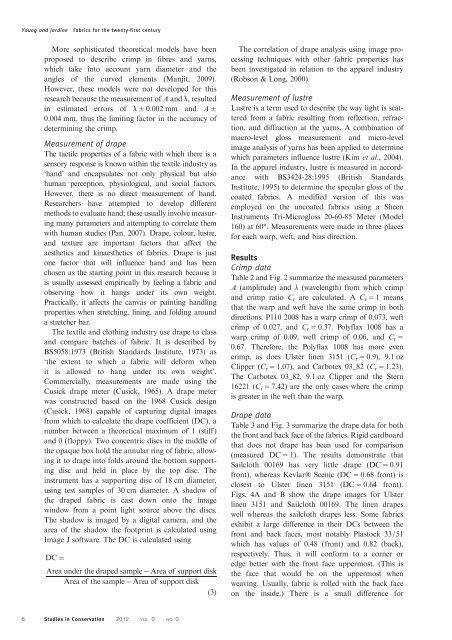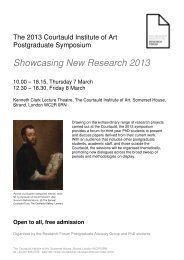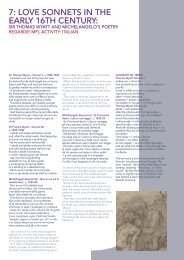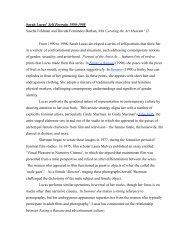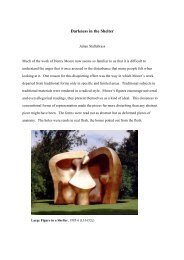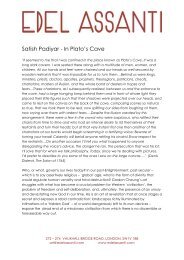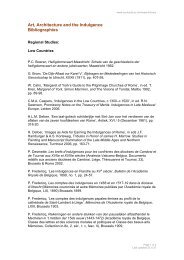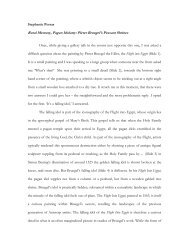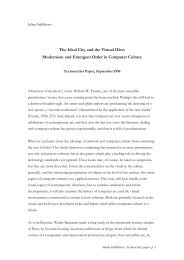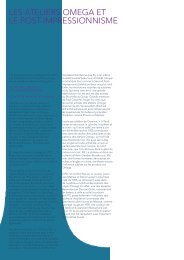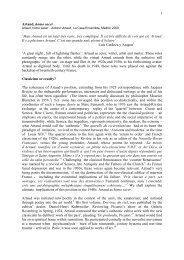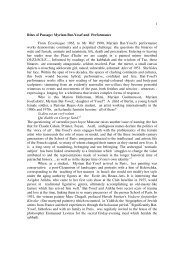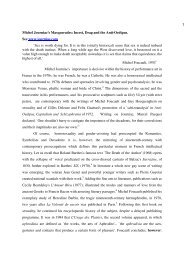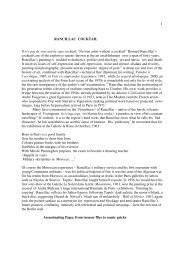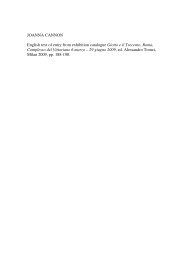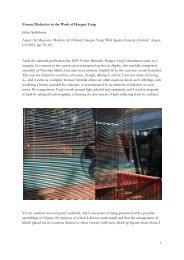Fabrics for the twenty-first century - The Courtauld Institute of Art
Fabrics for the twenty-first century - The Courtauld Institute of Art
Fabrics for the twenty-first century - The Courtauld Institute of Art
Create successful ePaper yourself
Turn your PDF publications into a flip-book with our unique Google optimized e-Paper software.
Young and Jardine <strong>Fabrics</strong> <strong>for</strong> <strong>the</strong> <strong>twenty</strong>-<strong>first</strong> <strong>century</strong><br />
6<br />
More sophisticated <strong>the</strong>oretical models have been<br />
proposed to describe crimp in fibres and yarns,<br />
which take into account yarn diameter and <strong>the</strong><br />
angles <strong>of</strong> <strong>the</strong> curved elements (Manjit, 2009).<br />
However, <strong>the</strong>se models were not developed <strong>for</strong> this<br />
research because <strong>the</strong> measurement <strong>of</strong> A and λ, resulted<br />
in estimated errors <strong>of</strong> λ ± 0.002 mm and A ±<br />
0.004 mm, thus <strong>the</strong> limiting factor in <strong>the</strong> accuracy <strong>of</strong><br />
determining <strong>the</strong> crimp.<br />
Measurement <strong>of</strong> drape<br />
<strong>The</strong> tactile properties <strong>of</strong> a fabric with which <strong>the</strong>re is a<br />
sensory response is known within <strong>the</strong> textile industry as<br />
‘hand’ and encapsulates not only physical but also<br />
human perception, physiological, and social factors.<br />
However, <strong>the</strong>re is no direct measurement <strong>of</strong> hand.<br />
Researchers have attempted to develop different<br />
methods to evaluate hand; <strong>the</strong>se usually involve measuring<br />
many parameters and attempting to correlate <strong>the</strong>m<br />
with human studies (Pan, 2007). Drape, colour, lustre,<br />
and texture are important factors that affect <strong>the</strong><br />
aes<strong>the</strong>tics and kinaes<strong>the</strong>tics <strong>of</strong> fabrics. Drape is just<br />
one factor that will influence hand and has been<br />
chosen as <strong>the</strong> starting point in this research because it<br />
is usually assessed empirically by feeling a fabric and<br />
observing how it hangs under its own weight.<br />
Practically, it affects <strong>the</strong> canvas or painting handling<br />
properties when stretching, lining, and folding around<br />
a stretcher bar.<br />
<strong>The</strong> textile and clothing industry use drape to class<br />
and compare batches <strong>of</strong> fabric. It is described by<br />
BS5058:1973 (British Standards <strong>Institute</strong>, 1973) as<br />
‘<strong>the</strong> extent to which a fabric will de<strong>for</strong>m when<br />
it is allowed to hang under its own weight’.<br />
Commercially, measurements are made using <strong>the</strong><br />
Cusick drape meter (Cusick, 1965). A drape meter<br />
was constructed based on <strong>the</strong> 1968 Cusick design<br />
(Cusick, 1968) capable <strong>of</strong> capturing digital images<br />
from which to calculate <strong>the</strong> drape coefficient (DC), a<br />
number between a <strong>the</strong>oretical maximum <strong>of</strong> 1 (stiff)<br />
and 0 (floppy). Two concentric discs in <strong>the</strong> middle <strong>of</strong><br />
<strong>the</strong> opaque box hold <strong>the</strong> annular ring <strong>of</strong> fabric, allowing<br />
it to drape into folds around <strong>the</strong> bottom supporting<br />
disc and held in place by <strong>the</strong> top disc. <strong>The</strong><br />
instrument has a supporting disc <strong>of</strong> 18 cm diameter,<br />
using test samples <strong>of</strong> 30 cm diameter. A shadow <strong>of</strong><br />
<strong>the</strong> draped fabric is cast down onto <strong>the</strong> image<br />
window from a point light source above <strong>the</strong> discs.<br />
<strong>The</strong> shadow is imaged by a digital camera, and <strong>the</strong><br />
area <strong>of</strong> <strong>the</strong> shadow <strong>the</strong> footprint is calculated using<br />
Image J s<strong>of</strong>tware. <strong>The</strong> DC is calculated using<br />
DC =<br />
Area under <strong>the</strong> draped sample − Area <strong>of</strong> support disk<br />
Area <strong>of</strong> <strong>the</strong> sample − Area <strong>of</strong> support disk<br />
(3)<br />
Studies in Conservation 2012 VOL. 0 NO. 0<br />
<strong>The</strong> correlation <strong>of</strong> drape analysis using image processing<br />
techniques with o<strong>the</strong>r fabric properties has<br />
been investigated in relation to <strong>the</strong> apparel industry<br />
(Robson & Long, 2000).<br />
Measurement <strong>of</strong> lustre<br />
Lustre is a term used to describe <strong>the</strong> way light is scattered<br />
from a fabric resulting from reflection, refraction,<br />
and diffraction at <strong>the</strong> yarns. A combination <strong>of</strong><br />
macro-level gloss measurement and micro-level<br />
image analysis <strong>of</strong> yarns has been applied to determine<br />
which parameters influence lustre (Kim et al., 2004).<br />
In <strong>the</strong> apparel industry, lustre is measured in accordance<br />
with BS3424-28:1995 (British Standards<br />
<strong>Institute</strong>, 1995) to determine <strong>the</strong> specular gloss <strong>of</strong> <strong>the</strong><br />
coated fabrics. A modified version <strong>of</strong> this was<br />
employed on <strong>the</strong> uncoated fabrics using a Sheen<br />
Instruments Tri-Microgloss 20-60-85 Meter (Model<br />
160) at 60°. Measurements were made in three places<br />
<strong>for</strong> each warp, weft, and bias direction.<br />
Results<br />
Crimp data<br />
Table 2 and Fig. 2 summarize <strong>the</strong> measured parameters<br />
A (amplitude) and λ (wavelength) from which crimp<br />
and crimp ratio Cr are calculated. A Cr = 1 means<br />
that <strong>the</strong> warp and weft have <strong>the</strong> same crimp in both<br />
directions. P110 2008 has a warp crimp <strong>of</strong> 0.073, weft<br />
crimp <strong>of</strong> 0.027, and Cr = 0.37. Polyflax 1008 has a<br />
warp crimp <strong>of</strong> 0.09, weft crimp <strong>of</strong> 0.06, and C r =<br />
0.67. <strong>The</strong>re<strong>for</strong>e, <strong>the</strong> Polyflax 1008 has more even<br />
crimp, as does Ulster linen 3151 (Cr = 0.9), 9.1 oz<br />
Clipper (C r = 1.07), and Carbotex 03_82 (C r = 1.23).<br />
<strong>The</strong> Carbotex 03_82, 9.1 oz Clipper and <strong>the</strong> Stern<br />
16221 (Cr = 7.42) are <strong>the</strong> only cases where <strong>the</strong> crimp<br />
is greater in <strong>the</strong> weft than <strong>the</strong> warp.<br />
Drape data<br />
Table 3 and Fig. 3 summarize <strong>the</strong> drape data <strong>for</strong> both<br />
<strong>the</strong> front and back face <strong>of</strong> <strong>the</strong> fabrics. Rigid cardboard<br />
that does not drape has been used <strong>for</strong> comparison<br />
(measured DC = 1). <strong>The</strong> results demonstrate that<br />
Sailcloth 00169 has very little drape (DC = 0.91<br />
front), whereas Kevlar® Scenic (DC = 0.68 front) is<br />
closest to Ulster linen 3151 (DC = 0.64 front).<br />
Figs. 4A and B show <strong>the</strong> drape images <strong>for</strong> Ulster<br />
linen 3151 and Sailcloth 00169. <strong>The</strong> linen drapes<br />
well whereas <strong>the</strong> sailcloth drapes less. Some fabrics<br />
exhibit a large difference in <strong>the</strong>ir DCs between <strong>the</strong><br />
front and back faces, most notably Plastock 33/51<br />
which has values <strong>of</strong> 0.48 (front) and 0.82 (back),<br />
respectively. Thus, it will con<strong>for</strong>m to a corner or<br />
edge better with <strong>the</strong> front face uppermost. (This is<br />
<strong>the</strong> face that would be on <strong>the</strong> uppermost when<br />
weaving. Usually, fabric is rolled with <strong>the</strong> back face<br />
on <strong>the</strong> inside.) <strong>The</strong>re is a small difference <strong>for</strong>


